You’ve heard of GooseWatch! Get ready for GooseWatch! Why stick to tracking your geese through space? Why not time? A guide for UW time travelers.
Don't wanna be here? Send us removal request.
Text
GooseWatch: A Digital History Project
Introduction
Have you ever just stopped and realized how important Canadian geese really are to UWaterloo culture? I mean really. Just go to the campus store any spring term and you won’t fail to find an abundance of geese-themed paraphernalia, anything from t-shirts exclaiming “I Survived Nesting Season!” to your very own plush goose. The popularity of the Canadian goose penetrates all levels of Waterloo culture both on a institutional and student-driven scale. How did this species become Waterloo’s unofficial symbol and how has its interaction with Waterloo culture evolved over time. That’s what I’m trying to find out.
Research Purposes
To track the history of the goose as an unofficial symbol of UWaterloo
To identity what factors may have contributed to the rise of the goose in campus culture and triggered specific memes
To explore the effectiveness of digital history methodologies to explore and display historical trends
To encourage amateur historians and establish that even seeming inconsequential historical analysis is worthy of exploration
0 notes
Text
Nesting Sites: An Overview
Again, this probably isn’t going to be the most developed piece, but I hope it offers a bit of a guide of what I wanted to explore in this section.

Why Social Media?
Given that I’m analyzing the appearance of goose memes in uWaterloo culture, it would make sense to actually try to find instances of these memes. I’ve already scoured through Imprint to find images and textual references to geese (both humorous and otherwise), but this isn’t the only window into campus culture.
Moreover, social media sites allow for more individuals’ voices to be captured. Only a select few are involved in Imprint and make decisions on what appears in it. While we can assume that wider trends in campus culture do drive these decisions, it may be just as wise to look at more widely accessible mediums.
Analyzing the Sites
If we���re going to make any commentary about how the joke evolved, it’s important to keep its environment in mind. Certain websites breed certain types of humor, are better at hosting certain formats of information, and are better at spreading info. All of these aspects could easily impact the evolution and spread of certain forms of humour.
The Web in General
In a more general sense, I guess this section is really about how the internet and uWaterloo communities on the web have been involved in making the goose both a meme and a de facto mascot of the university. If we look into issues of Imprint, the rise of geese popularity definitely falls into the Web 2.0 era. Around the 2000s is really when things begin to grow. It might be the case that geese populations or even behaviour was never the real driver, but just how to communicate with each other and having access to tools that allow us to manipulate images, video, and text.
0 notes
Text
Timeline
This section is meant to include a timeline depicting major events on campus as well as the starting dates of goose appearances in certain contexts.
This was meant to provide a visualization to better communicate the historical trends and the relationship between certain types of events. Had this timeline been made, different types of events would have appeared in different colours. For instance, events affecting campus geography would appear in green, major changes in goose populations would have been in blue, instances of the goose appearing in campus culture would be red, and developments in social media access would be in yellow.
By colour-coding these different types of events, it might be possible to nice trends between certain events.
0 notes
Text
Space and Time (Spatial History): Overview
rUnfortunately, this section was just way beyond my scope in both skills and time to complete. I will give you some sense of what ideas may have been explored here and what sources/methods could have been applied.
GooseWatch (The Other One): A History
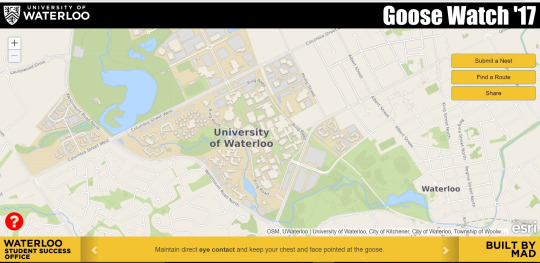
In Spring of 2013, the Student Success Office became interested in joining the goose meme fun (and probably ensure that students aren’t attacked by angry parent geese) and began mapping out nesting sites based on tweets of their locations. Eventually Mapping, Analysis and Design (MAD) got involved and, now GooseWatch exists as a crowd sourced map of goose nesting sites.
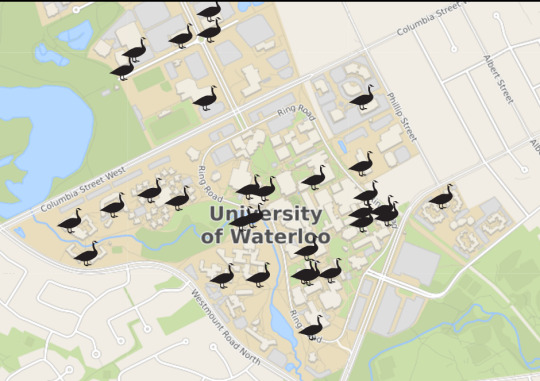
I’m actually a bit terrified. THERE’S SO MANY.
Eventually this information might come in handy when figuring out how changes in the campus landscape impact geese nesting habits. Maybe individuals in certain majors are more likely to hate/embrace the #gooselyfe based on their experiences with nests. Having a map of these nests over time makes these questions possible to consider.
While I can’t seem to find the past nesting locations via google, GooseWatch is run through Waterloo’s Open Data Initiative so it may be possible to access past year’s data. If not, one would probably be able to find past screenshots on social media of the site or (worse case scenario) simply do what its creators initially did. Search through social media for sightings and map them out. There’s also this from 2015 available.
So that’s one thing I wanted to play around with in this section because this does relate very strongly to geese spatial history, but beyond that there’s other things to consider as well.
Columbia Lake
Something a lot of people don’t seem to recognize is that Columbia Lake was actually artificially created. When Laurel Creek was being realigned, the lake was added to act both as a reservoir and a recreation area. Seeing that there is documented information that the lake is used by Canadian Geese, at first I considered looking into how the lake changed local geese populations and if that changed geese appearances in campus culture. As it turns out, the lake was developed in the 1960s. With uWaterloo only existing since 1957, this doesn’t leave a huge “before” time span to look at. Even then, I would argue (based on my text and image search of Imprint and Chevron’s early issues) that it didn’t impact campus culture as after the development no more geese were mentioned more than before. So yes, goose populations may have risen but it seems this wasn’t that drove the change in its appearance in campus culture.
On the other hand, changes to the lake did take place in 2004 so maybe that changed somethings.
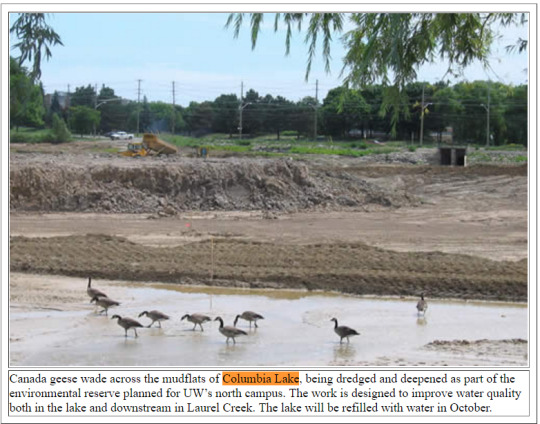
Other Changes in Campus Geography
Another interesting subject to consider is how new campus buildings played a role.
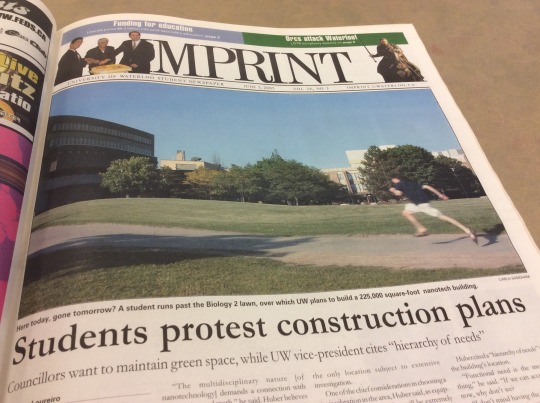
In 2004, there were huge concerns by students about the loss of green space on campus. The development of new infrastructure (in this case the Quantum Nanotech Centre) over the years has put concrete in the place of green space. Fun fact: Canadian Geese like a) grass and b) open areas where they can see all potential incoming predators. So you’d imagine that geese populations would have gradually dropped after these green spaces were build on. Knowing this, maybe goose population and campus obsession with geese don’t relate. Maybe the geese have less places to go and are now in spaces where humans transit through more? That’s another thing to consider. Had GooseWatch existed for longer maybe that’s something that could have been found out.
Duck, Duck, Goose
A final thing I’d explore is the banks of Laurel Creek. This isn’t something I can comment on definitively, but I heard it through the grapevine (i.e. Environment students) that in the past. We used to have a high duck population. To address this, the campus supposedly altered the borders of the creek, removing plant species that attract duck but while ducks diminished a bit somehow Canadian Geese became the new issue. Eventually, work that been done to restore this vegetation but the damage as been done and now spawn of Satan infect campus. Or as legend says-
It definitely makes a fun story about where the geese came from (at least from an ecology nerd sort of view), but whether it’s true or not- I haven’t been able to find much information on it. Either the Environment students and profs have been messing with me or their knowledge of campus events and changes is a lot more expansive than what’s preserved on the internet and accessible archives.
It totally is possible that these issues would be information seen/noticed by Environment students/profs present during such changes or passed down through oral history. So a) checking out this theory in and of itself would be cool, but even b) finding out whether the narrative is true and finding out how it got passed along and with how much accuracy is also a cool exploration as well.
Conclusion
Hopefully, this section at least gives you some sense of what can be done in exploring the relationship between changes in space and trends in time. Whether I or whether you actually go ahead and go ahead and explore this one day is anyone’s guess, but at very least I hope these proposed plans and observations help in some way.
0 notes
Text
Podcast Interview Questions
Due to hold-ups in receiving Ethics approval, as well as just generally realizing that (even with approval) exam season isn’t an ideal time for myself or potential interviewees, I’d held back on adding actual content to this section.
In lieu of an actual podcast, I’ve added a random audio file (i.e. the Duck Tales theme) to at very least demonstrate how these interviews would be incorporated into the site.
Below are a list of questions that would have been used for the interviews:
From what dates did you teach or study at the University of Waterloo?
During your time on campus, how would you describe your experiences with local Canadian geese populations? Do you think your opinion of the animal has changed after becoming a student or staff member at UW?
Before attending/teaching at the university, did you ever hear any conversation about Canadian geese on campus?
Do you feel as if the goose has become an unofficial symbol of our university? Why or why not? If yes, what do you think prompted this?
Do you own any geese-themed Waterloo merchandise?
Have you drawn/written anything about the Canadian goose for humorous purposes or otherwise?
Describe any situations you can remember of the goose being used for advertising purposes by the university/student groups.
Do you feel as if geese populations have changed (either in size, common location, or behaviour) during your time on campus? How were they before and how are they now?
During your time in Waterloo, what other discussions or on-going jokes seemed prevalent at the time?
0 notes
Text
A Journey Through Imprint
To get an idea of how and when the Canadian goose evolved into the de facto mascot it is today, a reasonable place to start is Imprint, the University of Waterloo’s official student newspaper. With its first issue published in 1978, Imprint is one of the major and most accessible venues into uWaterloo’s past. Along with its predecessor The Chevron, Imprint offers a glance into Waterloo’s past campus culture, humor, and events. Even better, there’s even a handy online archive accessible through the Imprint website that allows one to control-f their way through all its publications. Unfortunately, a limitation of this is that control-f cannot detect visuals, which I argue are just as important and telling as words. As such, today I’ll be giving you a brief overview of what I discovered after culling through a mass of Imprint issues.
Realistically, if I wanted my results to be more reliable, I would have gone through each and every issue. Unfortunately, I neither have the time or patience to do that. Instead, I started with the first volume and moved in increments of five, attempting to find when geese-related images begin appearing.
What I found was this:

In the first volume of Imprint, there is only one image of a Canadian goose. What’s important to note about this image, is that there does not seem to be any humorous intent behind it or anything to suggest its role as a mascot. In general, it’s just a very neutral image.


Porcellio, the current Arts Faculty mascot, seemed to have a stronghold over the de facto uWaterloo mascot position, making a cameo appearance in both a “Campus Question” segment and the April Fool’s edition of the newspaper. Interestingly enough, Porcellio was first donated in 1978, the year Imprint was first released. With the warthog making an appearance twice in a lovable mascot context suggested it was taken to quite quickly.
By 1997, the goose still had not made a re-appearance in the paper, but another waterfowl did.
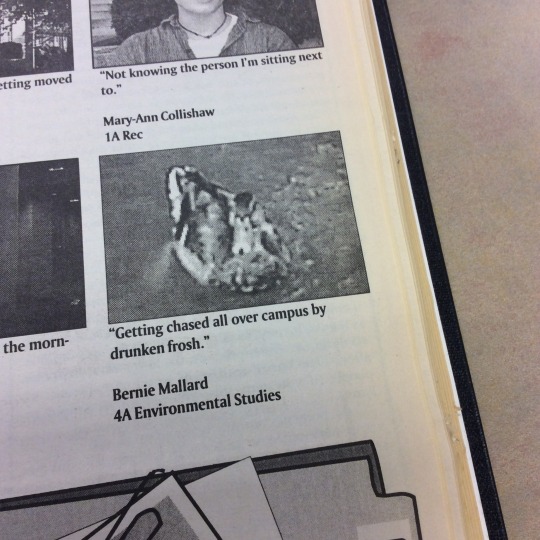
Meet Bernie Mallard, 4A Environmental Studies student and hater of drunken frosh.
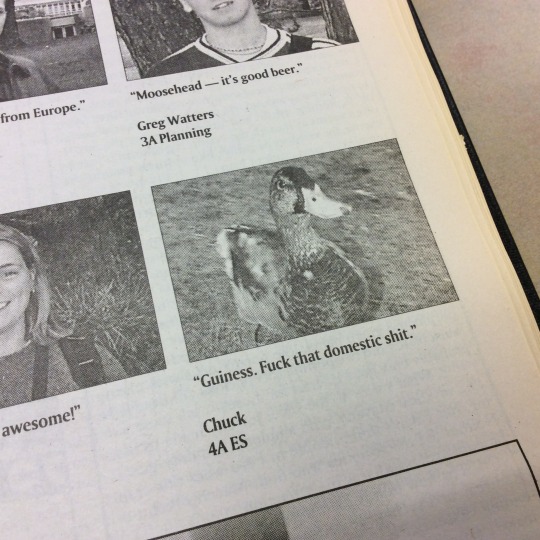
Also Chuck
Throughout 1997-1998, ducks enrolled in ES were offering up their opinions on student life in segments of the “Campus Question”. While Bernie only made one appearance, Chuck never failed to make an appearance every few issues with something to say.


Oh Chuck, you quack me up.
In 1998-1999, Chuck graduates and is replaced with this alien guy.

But lo and behold, what do we have here.

Geese!
Unfortunately, this is their only appearance.

As their absence from this question (”If Arts had a mascot/symbol, what would it be”) might suggest by 1999 the Canadian Goose had not yet been embraced by the student population.
It isn’t really until 2005 where the goose enters the scene as a symbol/humorous character.
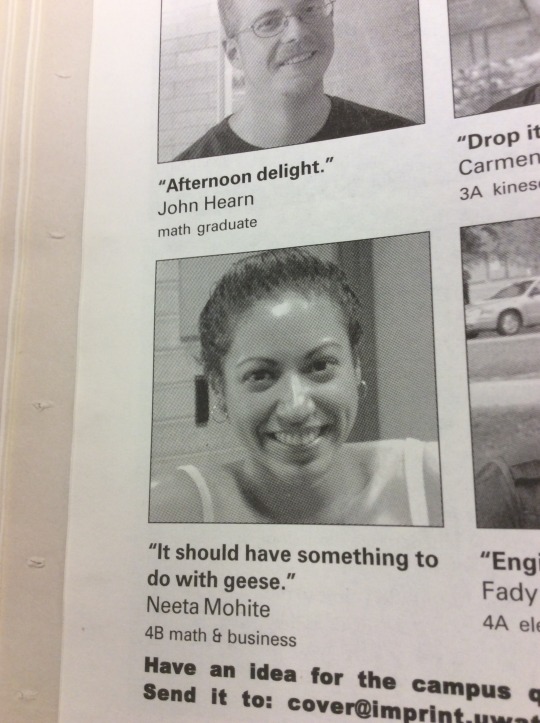
“Campus Question” appears to be a good indicator of running on-campus jokes.
And then it vanishes AGAIN until 2008, in which case the "Campus Events" banner features Canadian geese silhouettes-

- and photographs.

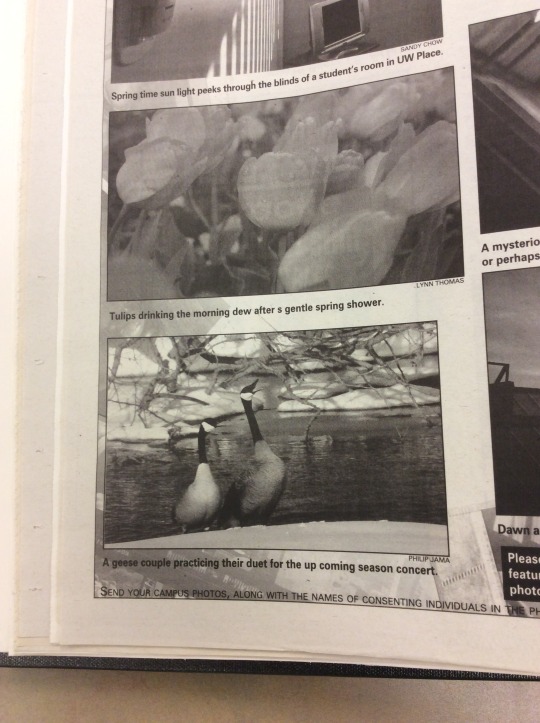
and-

this guy!
In the following year, there’s an entire comic dedicated to geese entitled “The Geese”
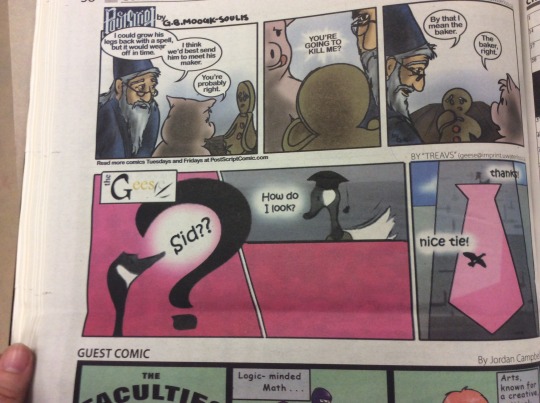

The appearance of both the Pink Tie and “The Egg” confirm that the popularity of the species is sourced from their presence on campus and not their appearance elsewhere in Canada.
The series continues into the new year. Most depict the goose in a lovable light, however some are more negative.

Goose in student scenario. I.e. very human and sympathetic representation and NOT demon spawn

That’s more familiar to the geese I know.
Another interesting note to add is that Porcellino makes a major comeback.
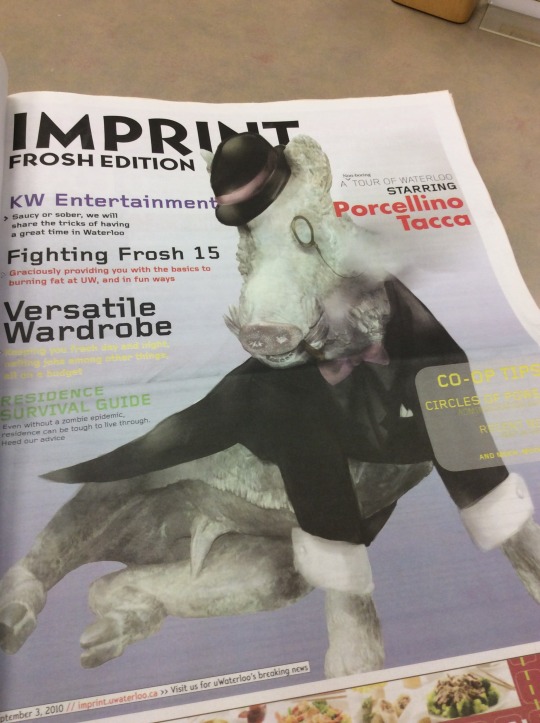
By 2011-2012, the geese begin appearing in other comics and are considered important aspects of campus life.

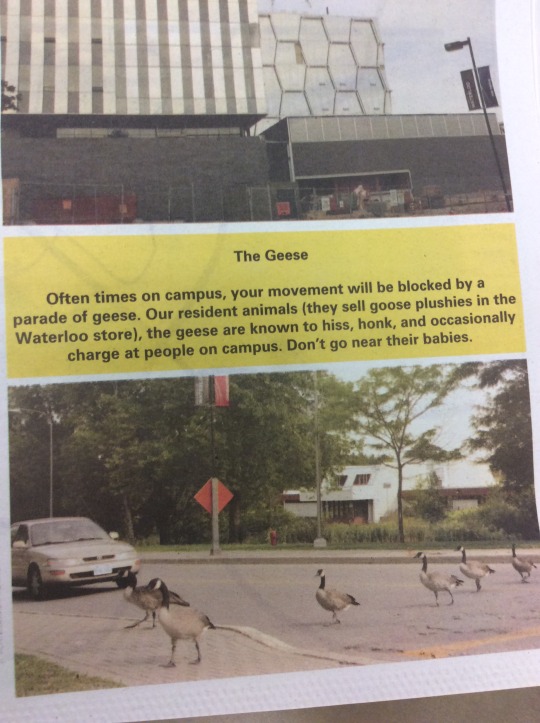
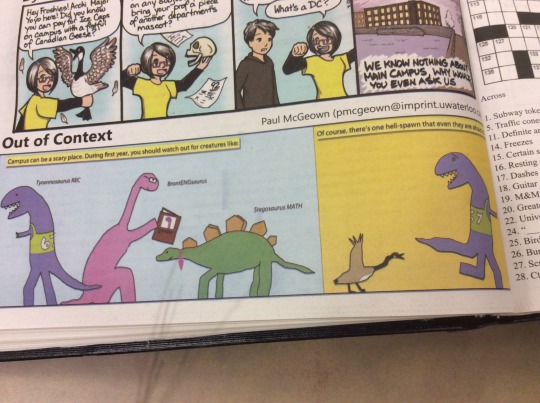
Note how these representations are a lot more negative in nature than the images from the previous years.
From 2012 onward the goose continues to appear in contexts beyond just comics and featured articles. By now, the species appears in situations where it seems to represent the university.

For instance, this goose pirate ship.(Note how top hat Porcellino has reappeared in this issue as well).
2012 is also a year where the goose makes a species of cameo appearances in editorial cartoons.

This pattern continues into 2013 and in 2014-2015, there’s a sudden influx of goose appearances.
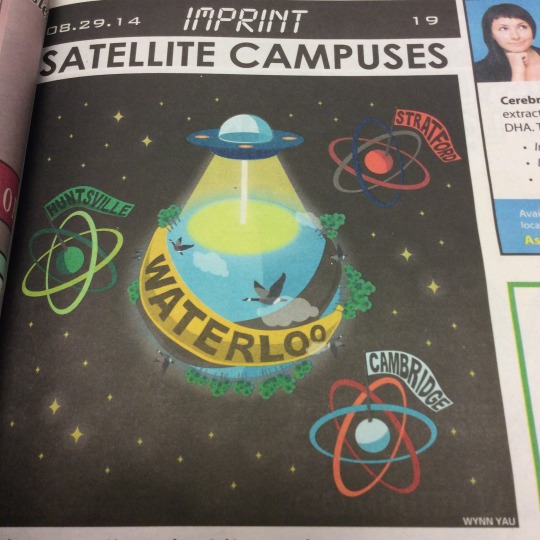
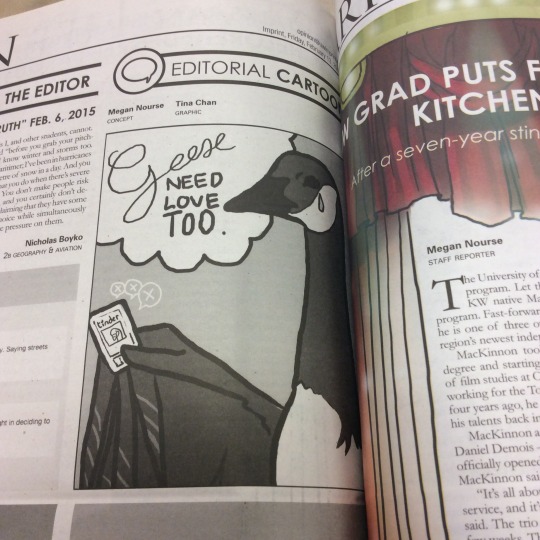

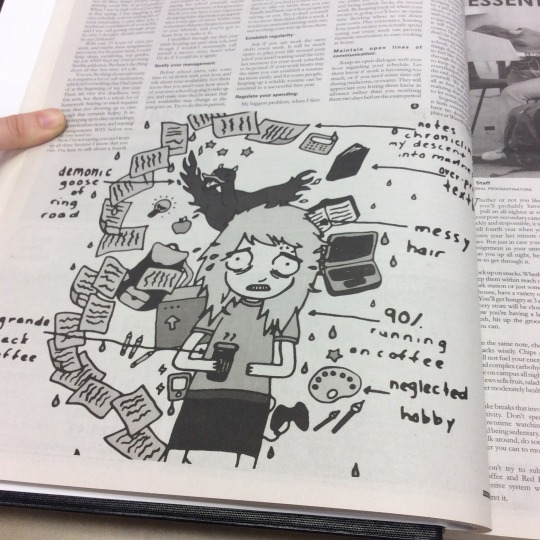
And that just about brings us to today-

Imprint 2017. Join the Geese.
0 notes
Audio
Timestamps:
0:20 – DuckTales Intro 1:08 – Probably still DuckTales 2:20 – Still Ducktales 3:00 – Closing Rift
0 notes